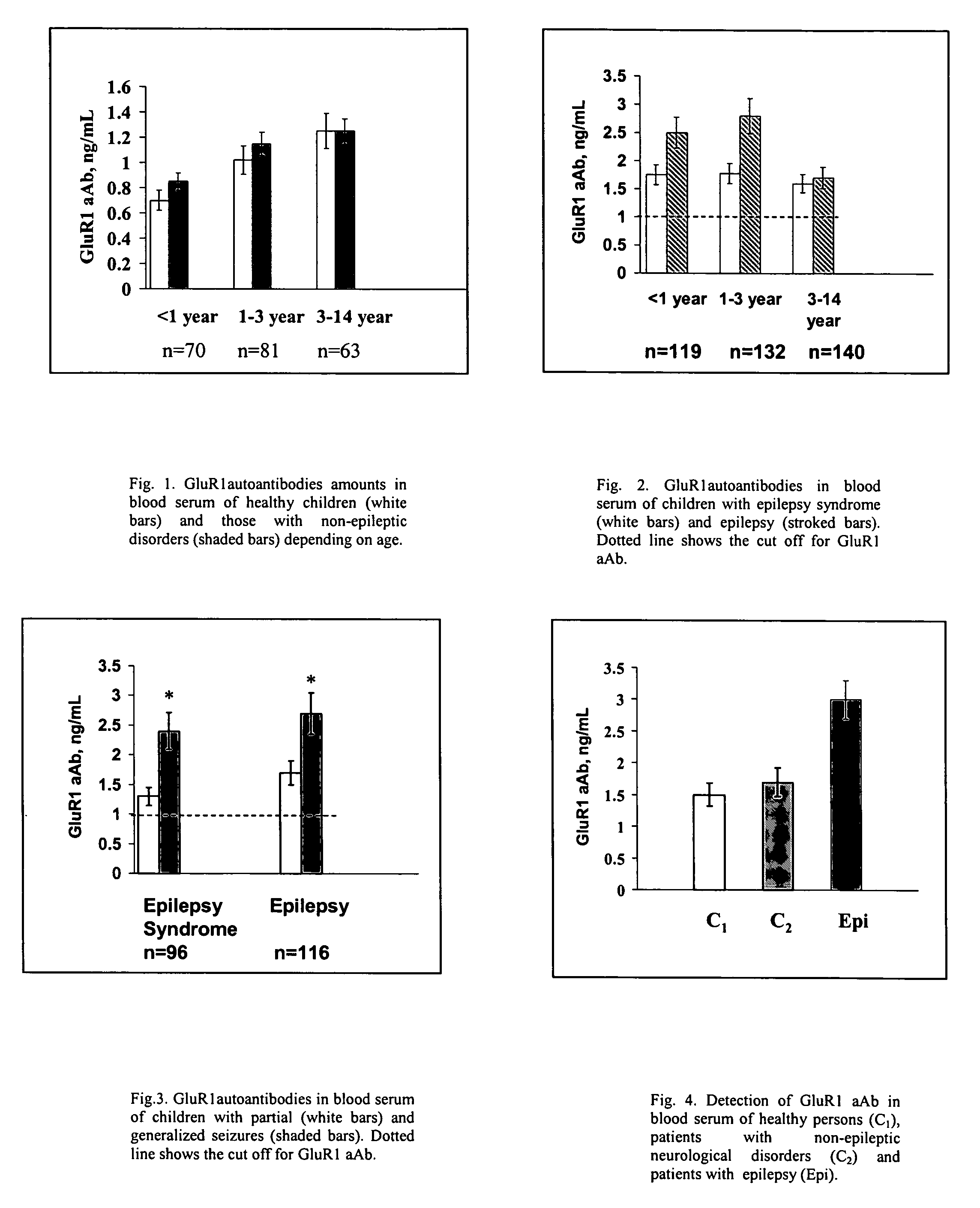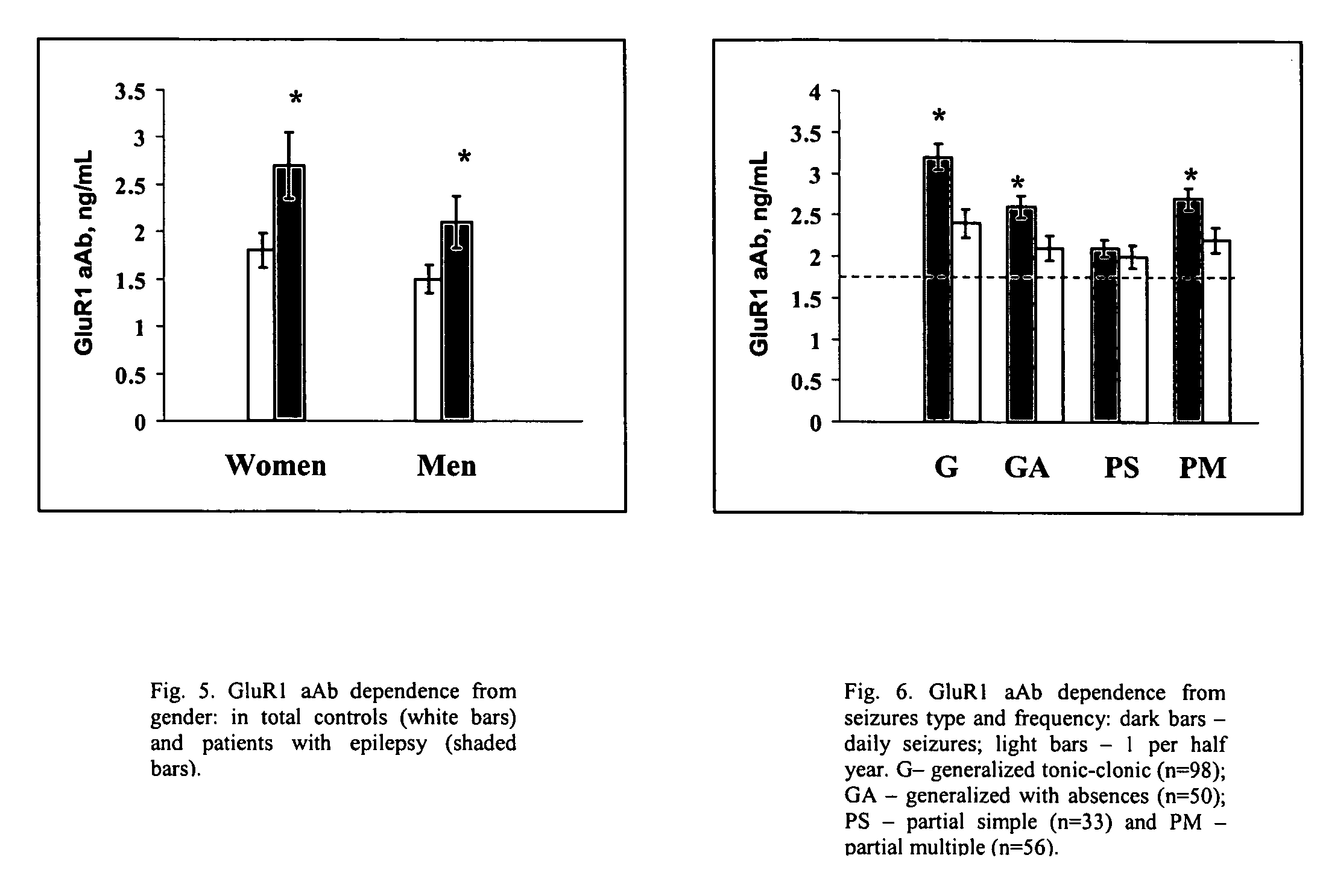Immunosorbent blood tests for assessing paroxysmal cerebral discharges
a paroxysmal cerebral discharge and immunosorbent technology, applied in the field of invitro diagnostic tests, can solve the problems of difficult to distinguish between epileptic seizures, begin to destroy the components of the cell membrane, and difficult to distinguish between these types of seizures, and achieve rapid and inexpensive immunoassays and effective therapeutic interventions.
- Summary
- Abstract
- Description
- Claims
- Application Information
AI Technical Summary
Benefits of technology
Problems solved by technology
Method used
Image
Examples
example 1
Clinical Assessment of Epilepsy in Children
[0087]This randomized and double-blinded trial was conducted at 4 Children Epilepsy Centers in Moscow and St. Petersburg (Russia) from, January 1995 through December 1999. Although our study is not strictly population-based, we recruited individuals to achieve a group representative of children with epilepsy in the western part of the country.
[0088]Eligible for the trials patients were at 4 mo.-14 years of age and had been diagnosed with epilepsy syndromes and seizures that were classified based on all information available at diagnosis and according to International League Against Epilepsy's (ILAE) guidelines by four pediatric epilepsy specialists. These include the localization-related and generalized idiopathic syndromes (e.g., benign rolandic and childhood absence epilepsy), and the cryptogenic and symptomatic generalized syndromes. The symptomatic and cryptogenic localization-related epilepsies represent a broad spectrum of syndromes d...
example 2
Clinical Assessment of Adult Epilepsy
[0103]Double-blinded trial was conducted at Dept. of Epilepsy, V.M Bechterev's Institute on Psychiatry and Neurology and Dept. of Neurology, Russian Military Medical Academy in St. Petersburg (Russia) from February 1994 to December 1997. Two hundred thirty seven consecutive patients with epilepsy aged 18 to 40 years (130 women, 107 men) admitted to hospitals of aforementioned institutions due to increased frequency of seizures were considered for participation. Epilepsy was classified according to ILAE guidelines and the following inclusion criteria were considered in the protocol: the duration of disorder from 1 year to 20 years; the frequency of seizures from 1 per day to one per a year; type of seizures: partial simple, partial multiple, generalized with absences, generalized tonic-clonic of different etiology (e.g., history of bacterial meningitis, stroke, cerebral palsy, prenatal trauma etc.). A definite diagnosis of epilepsy was based on we...
example 3
GRACE-NeuroTest-Epilepsy ELISA Tests Performance
[0111]The GRACE-NeuroTest-Epilepsy ELISA kits for detecting GluR1 antibodies comprises (i) an immunosorbent for GluR1 peptide or antibodies to GluR1; and (ii) an indicator reagent comprising secondary antibodies attached to a signal-generating compound. The test intended to be used to assess persons undergoing paroxysmal cerebral discharges and epilepsy.
[0112]The quality of microplates covered by GluR1 peptide or antibodies to GluR1 was controlled by use of calibrators and sera specimens from healthy persons in presence and absence of calibrators (Gromova et al., Neirokhimiia. 1997, 1:23-7). The assessments of intra-assay variability, batch-to-batch variation and stability of the ELISA reaction for antibody or GluR1 calibrators were performed at various storage conditions (temperature, type of packing, storage duration). Kinetic of reaction was studies to reach optimal characteristics of variables. The concentrations of GluR1 peptide o...
PUM
| Property | Measurement | Unit |
|---|---|---|
| concentration | aaaaa | aaaaa |
| concentration | aaaaa | aaaaa |
| concentration | aaaaa | aaaaa |
Abstract
Description
Claims
Application Information
 Login to View More
Login to View More - R&D
- Intellectual Property
- Life Sciences
- Materials
- Tech Scout
- Unparalleled Data Quality
- Higher Quality Content
- 60% Fewer Hallucinations
Browse by: Latest US Patents, China's latest patents, Technical Efficacy Thesaurus, Application Domain, Technology Topic, Popular Technical Reports.
© 2025 PatSnap. All rights reserved.Legal|Privacy policy|Modern Slavery Act Transparency Statement|Sitemap|About US| Contact US: help@patsnap.com



